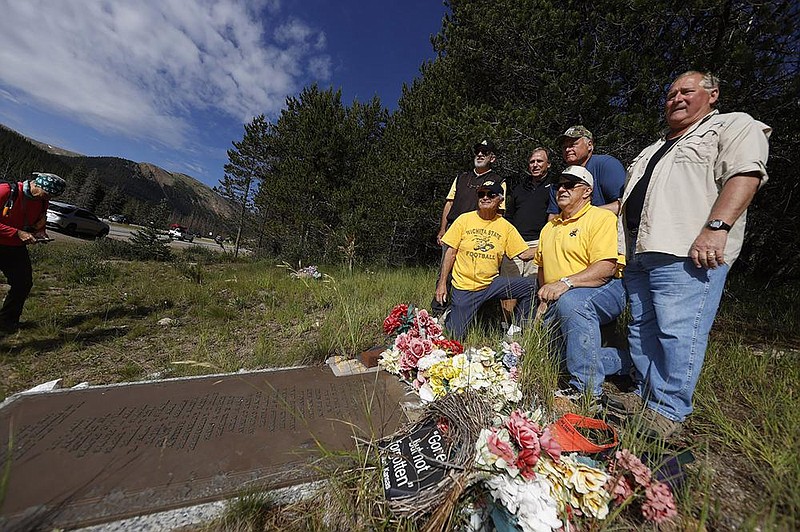SILVER PLUME, Colo. -- In a small clearing on Mount Trelease, a faded and tattered yellow shirt rests among twisted shards of metal.
Emblazoned across the front: Wichita State.
A heavy reminder of what took place 50 years ago in this section of the Colorado Rocky Mountains where memorials and tributes dot the scarred landscape.
It's here a plane carrying the Wichita State football team crashed while traveling to a game at Utah State on Oct. 2, 1970. Of the 40 on board, 31 died, including 14 players along with coaches, boosters, administrators, trainers and three crew members.
It's also here, a steep climb at 11,000 feet, that many have ventured. Loved ones, to leave keepsakes. Teammates, to say a tearful goodbye. Survivors of the crash, too, like defensive lineman Dave Lewis who went a decade ago because, "I wanted to look at it to see what this place of horror resembled in peace. My friends died there."
From the mountainside to an annual observance on the Wichita, Kansas, campus, that tragic day remains etched in history. The school will hold a remembrance Friday at Cessna Stadium, where the Shockers played until the football program was disbanded for cost-cutting reasons in 1986.
Many touched by the tragedy will be there. To cry. To honor. To remember.
Two twin-engine planes left that picture-perfect autumn morning from Wichita for the game in Logan, Utah.
On the "Gold" plane were the starters, along with head coach Ben Wilson and his wife, Helen. Neither survived.
On the "Black" aircraft were the reserves.
The planes stopped in Denver to refuel. While there, one of the pilots, Ron Skipper, bought aeronautical charts at the airport. The plane carrying the starters went on a sightseeing tour , while the reserves' aircraft followed the original flight plan through Wyoming and over to Logan.
The pilots flew low through a closed-in canyon with little room on each side.
Packed with people and football equipment, the pilots realized too late they weren't going to be able to pull up in time to clear the approaching peaks.
They banked the plane sharply to the right, trying to turn around. The plane clipped the tops of the trees before crashing into the place where chunks of metal now remain on the charred mountainside.
Offensive tackle Mike Bruce scrambled through the forest that afternoon and down the slope in search of help, eventually reaching an opening near where Interstate 70 now passes.
"I heard the explosion," Bruce recalled. "I thought everybody survived -- until the next day."
Bruce didn't play football again.
"I could've health-wise. But emotionally, I just couldn't," Bruce said. "I never went back into that dressing room again."
Not long after the tragedy, the team voted to play football again that season.
With 14 players killed and more injured, the Shockers received permission from the NCAA to use freshmen. Assistant coach Bob Seaman stepped in for Wilson.
In between practices, the players attended funerals.
Their first game back in the "Second Season" was against highly-ranked Arkansas on Oct. 24. The Shockers were beaten 62-0.
The memorable moment was John Hoheisel, one of the crash survivors, limping out to midfield on crutches for the coin flip.
"The people in Little Rock were just absolutely loving and very sympathetic," said kicker John Potts, who organized a reunion between the two teams a few years ago. "It was an honor to play in that game."
Ken Duren was working at a shoe store in Oklahoma City that afternoon when his father called. He'll never forget the sound of his dad's voice telling him that John, his younger brother and a defensive back for the Shockers, had been in a plane crash.
It took days to learn his brother didn't survive.
"My brother was a special kid," Duren said. "It was a tragedy of monumental proportions."
Soon after, another tragedy: On Nov. 14, 1970, the Marshall University football plane crashed and killed 75 people, including most members of the team.
The story of the Marshall crash remains at the forefront in the American conscious, with Hollywood making the movie "We are Marshall" in 2006 and football still being played.
At Wichita State, there's no longer a football team to honor those who died in the crash.
Instead, their memories are preserved through families, teammates, friends and the school.
One of the caretakers of that history is John Yeros, a wide receiver who was on the reserve plane. He's been to the crash site more than 20 times since his first visit in 1972, when he took a piece of torn metal from the plane and brought it back to his dorm room.
Over the years, he's taken family members and survivors to the spot.
"It's always emotional going up there," Yeros said "I don't know when I've been up there and I haven't teared up."
In late July, Yeros organized an outing that included more than two dozen people. Former Shockers player Ed Plopa went on the trek along with Potts.
Lewis, who badly injured his left leg in the crash, journeyed back a decade ago to see the wreckage as part of a PBS documentary. He went with fellow survivors Rick Stephens and Randy Jackson, a talented tailback for the Shockers who spent three seasons in the NFL before returning to Wichita to become a longtime coach and teacher. Jackson died of pancreatic cancer a decade ago at 61.
On that visit, Lewis dug up a small pine tree and replanted the sapling in his yard in Overland Park, Kansas. He bought books on caring for the tree and watched it flourish.
A few years ago, the tree died of disease.
"I sat there on my deck and stared at where the tree was and cried," the 70-year-old Lewis said. "It was like one of my buddies died, because of where the tree came from. It was like it happened all over again."








